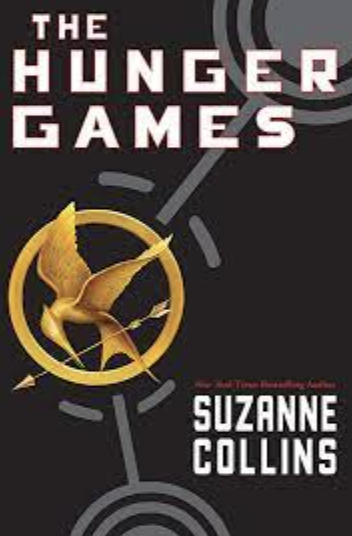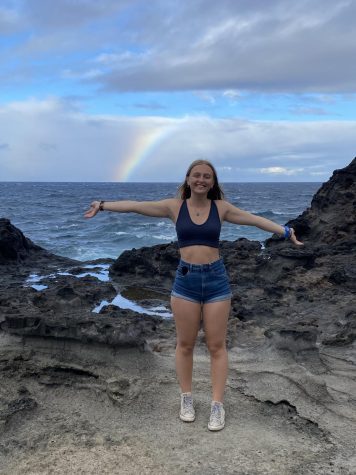“Hunger Games” by Suzanne Collins
Book critiques and reviews.

Cover of “The Hunger Games” depicting Katniss’s mockingjay pin.
June 11, 2023
In previous reviews, I have mentioned “The Hunger Games” by Suzanne Collins on a multitude of occasions. If you couldn’t tell, I basically worship these books on hands and knees. If I were to recommend any sort of dystopian novel to anyone seeking out a good series, I’m begging you to go read “The Hunger Games.”
“The Hunger Games,” while being well known, is not discussed enough in my opinion. Everyone waves it off as a book that only consists of a rebellion, a teen love, and a love triangle but I cannot say this enough, IT IS SO. MUCH. MORE.
While yes of course “The Hunger Games” has the romantic aspect, it is just a subplot.
The whole plot of “The Hunger Games” is a commentary on societal tendencies, and satirically picks at the concept of the rich taking advantage of the pain and death of the poor for their own enjoyment. It accentuates the idea that pacifism in the face of facism only helps to further its power, while also giving readers a strong female lead who does not fit the eurocentric beauty standards within the books.
The main premise of the book is set in a dystopian society loosely based on future America, that happened to go through a civil war. Such a civil war was won by the government, and in retribution against the rebellion, 2 children from each of the 12 districts were then forced to fight to the death in a battle of brute strength.
The 74th year of participating in these games is when the book series begins, and readers are introduced to District 12’s female tribute Katniss Everdeen. Katniss is a 16 year old girl, hellbent on keeping her family alive, and after her 12 year old sister is reaped, she takes her place in “The Hunger Games.”
Throughout the book, reader’s watch as Katniss must maneuver her way through this Game, where she is paraded, berated, and abused along with her fellow tributes all of which are under the age of 18. Only one is allowed to live out of all 24.
In my opinion, I believe the books grasp at the true meaning of what Collins was trying to portray much better than the movies. Of course, I believe that Jeniffer Lawrence did a wonderful job at her portrayal of Katniss, but seeing as very few of the actors actually were in the age range of the characters it didn’t have the same gutting feeling as I did in the books. Considering there were young baby’s being sent to brutally murder each other in a game for the fascination of adults.
In the movies, the characters were all above their actual age, and it made it less impactful than if they actually had younger children playing these characters.
An example of this is shown in the character Rue played by Amanda Stenberg. In the books Rue is the youngest tribute of the 74th Hunger Games, making her about 12. In the movies, Stenberg was 14 at the time of her participation, and although her portrayal of the childlike character easily moved viewers to tears, if she had been age accurate it would have been more harrowing to watch such a young person fight for their lives.
As a result of this, the movies just do not live up to the books. So if you were looking to choose which to go into first, I recommend books before movies.
One of my favorite parts of “The Hunger Games” is the fact that Katniss is just a girl. There is no prior planning for her to start a revolution, there was no plot for her before her sister is reaped. It is all completely up to chance and fate that it was she who sparked the revolution.
She is thrown into this position after a pure, unadulterated, act of survival and this brings this series into reality. It gives those who read it the idea that even the smallest of people can make a difference in the world with just the smallest act of Rebellion.
It promotes hope in the face of despair, and I don’t know how many times I could say this: this book needs to be read.


